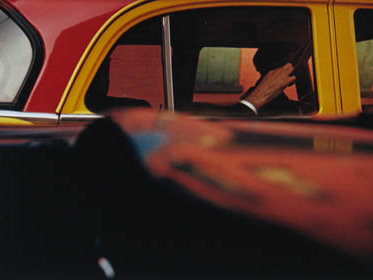The six photographers comprising Milwaukee Art Museum’s upcoming "Street Seen" exhibition found themselves at a cultural crossroads in America. Armed with the newly portable 35 mm camera, photographers Lisette Model, Louis Faurer, Ted Croner, Saul Leiter, William Klein and Robert Frank, came to exemplify the New York School of Photography’s spontaneous style in the 1940s and '50s.
All living in New York, they each independently pursued street photography with an in-depth look at the psychological and social transition of post-war America. The resulting images reveal an aesthetic revolution prizing spontaneity and subjective interpretation.
"The photos from WWII are grainy and blurry with very few parallel or perpendicular lines, but it was about action and participating in the moment rather than reporting it from afar, says Lisa Hostetler, curator of MAM’s "Street Seen." "Likewise, these photographers drew upon that aspect of photography and put it to use for their own ends."
Whether it was a conscious objective, as it was for Faurer and Croner, or simply a result of intrigue and interest, as it was for Leiter and Model, these six ventured to find a new identity in the midst of changes in popular culture, arts and everyday life. On a basic level, they used their own perspective and own stylistic lens to look at the seemingly routine actions of everyday Americans.
"Although there were a lot of photographers working at this time, these six seemed to share a particular approach; they are case studies of different angles of possibilities in photography as an art form of that era," Hostetler says.
Collectively, all six photographers documented New York City around the same time period employing abstract expressionism through spontaneity and chance. This movement would come to be known as the New York School of Photography but, individually, their subject, technique and focus differed quite a bit.
Leiter, who moved to New York at 23, played with the dynamic aspects of color at a time when the expense of color printing relegated it solely to the world fashion photography. Croner’s work shows an affinity for New York at night as he explored unorthodox angles. Model, who was born in Austria and moved to New York at the age of 37, bore a signature style of close-up, un-staged and un-retouched human portraits.
"I travelled all over, looking at collections, and I think the images in the show demonstrate the style and uniqueness of the artist’s vision," Hostetler says.
Both a master of still shot and film photography, Klein intentionally shot out of focus at very high-contrast and then severely over-exposed his negatives. Faurer, shooting daily in New York City and Philadelphia, embodied the juxtaposition of unarranged precision. While he played with any number of photographic elements including low-lighting, slow film speeds, blur, grain and reflection, he was strict in the dark room where he tirelessly cropped and printed to perfection.
While all worked as photographers in the fashion and commercial markets, Frank was perhaps the only one of the six to be recognized for his street achievement at the time. Propelled by the release of his book "The Americans," Frank’s work looked at separation of the upper and lower class, shattering perceptions of 1950s suburban bliss. Like all of his photography counterparts, his work exposed human emotions of loneliness and solitude.
All six photographers lived and shot in New York City. As a center for fashion and magazine publication, it was a city where photographers could regularly find work as photographers.
"Their struggle to take the camera into this urban, public space and find out who they are and understand their identity on a micro level can be seen on a macro level as America figured out who it was after WWII. There’s a parallel between the artist’s reflection on humanity and the American situation at the time," Hostetler says.
In addition to over 100 still images, the exhibit includes several film shorts. Klein’s "Broadway by Light," Faurer’s "Time Capsule," and film from independent film pioneer Rudy Burckhardt will run throughout the show.
"For several of these artists, still photography snowballed into film and I wanted to give a sense of that development in their work," Hostetler says.
Also, a Jackson Pollack drawing, two drawings from Willem de Kooning and two from Franz Kline will also complement "Street Scene."
"We included these not just because the artists and photographers knew each other and lived in the same neighborhoods, but there is a shared creative expression. In the way these photographers were using the camera, they really emphasized the subjective presence behind the camera. The sense of gesture and expression and subjectivity shares a lot with the painters who were trying to show the same thing; it’s the same gesture of individuality," Hostetler says.
"Street Seen" opens to members Thursday, Jan. 28, and to non-members on Saturday, Jan. 30. The exhibition runs through April 25.
OnMilwaukee.com staff writer Maureen Post grew up in Wauwatosa. A lover of international and urban culture, Maureen received a bachelor’s degree in sociology from the University of Wisconsin-Madison.
After living on the east side of Madison for several years, Maureen returned to Milwaukee in 2006.
After a brief stint of travel, Maureen joined OnMilwaukee.com as the city’s oldest intern and has been hooked ever since. Combining her three key infatuations, Milwaukee’s great music, incredible food and inspiring art (and yes, in that order), Maureen’s job just about fits her perfectly.
Residing in Bay View, Maureen vehemently believes the city can become fresh and new with a simple move across town.



